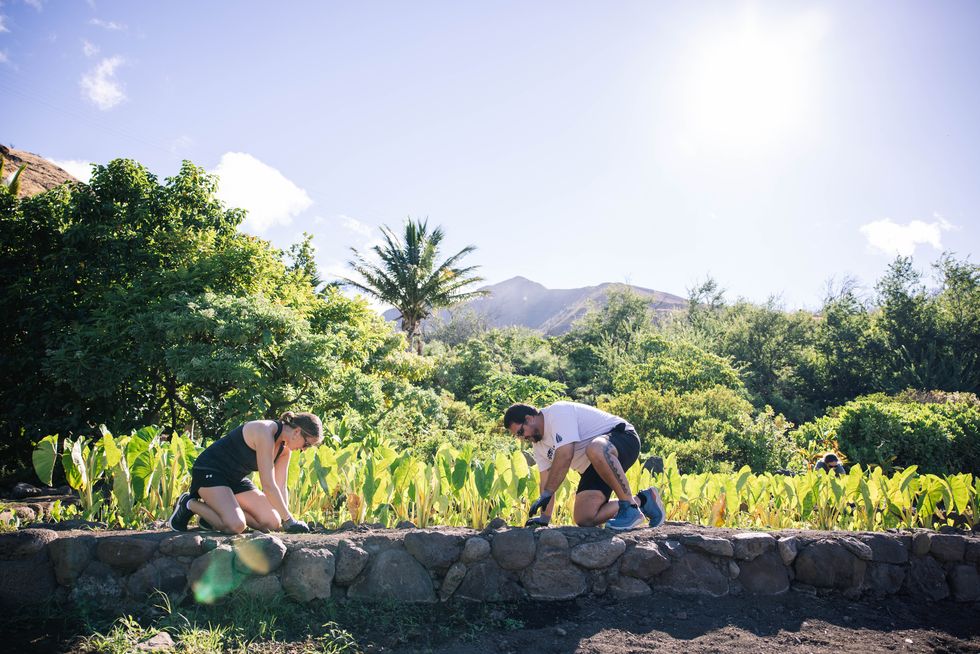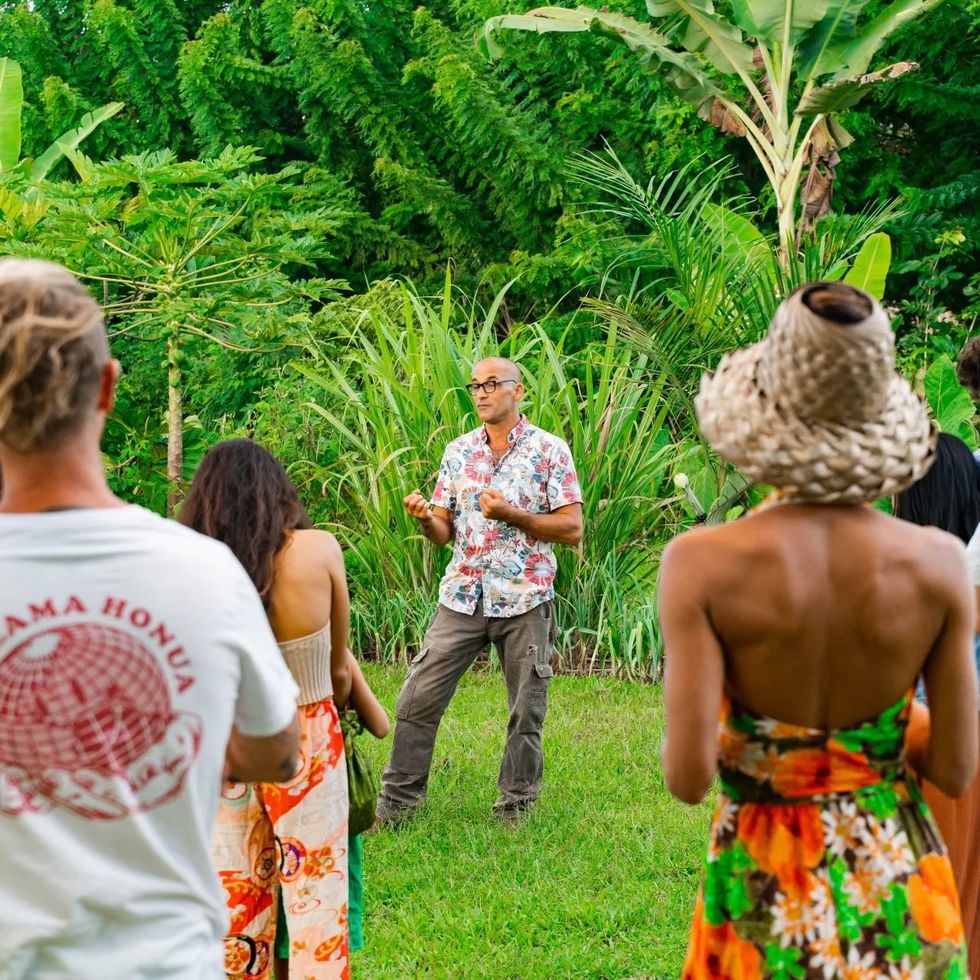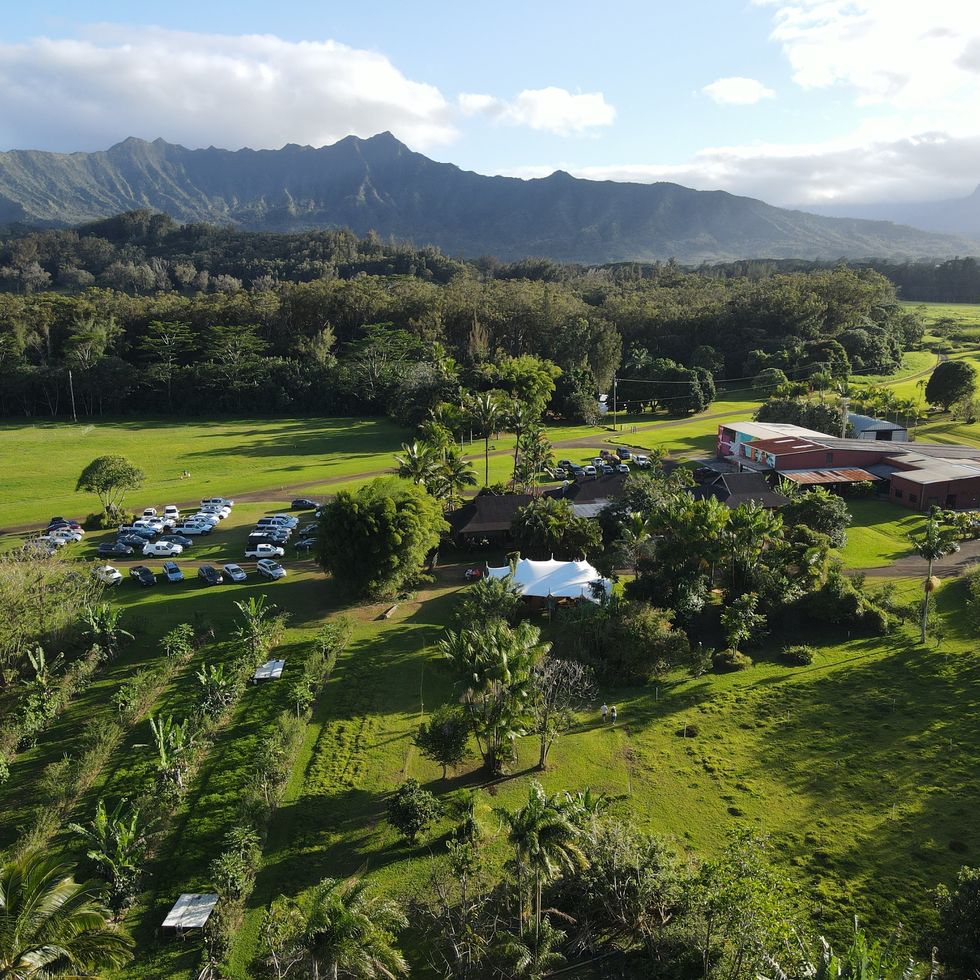I’m just going to go ahead and guess that if you live in a cold, dark area of the country right now (hi, me), you’ve been spending a lot of time dreaming of your next tropical getaway. And chances are, if you are also a White Lotus fan (hi, also me), that place may just be the Hawaiian Islands. After all, Hawai‘i’s crystal clear waters, gorgeous hiking trails, beautiful culture, and all the poke bowls you can eat = true sun-on-your-skin vacay perfection.
But hold up! Before you book your flight, there are a few things you should know about how not to be an entitled Shane (or a Shane’s mom) when you go. While it was indeed hilarious to watch the insufferable newlywed get all twisted about the Pineapple Suite “mix-up” in White Lotus season 1, his entire vacation vibe was also indicative of a much larger issue in the Aloha State right now: Overtourism has reached new heights—and both the locals and the land are suffering as a result. In October 2022 alone, an average of about 219,370 people visited Hawai‘i per day, up from about 215,125 in October 2019. Because of this post-pandemic travel boom, there are congested roads, hospitality worker shortages, overrun hiking trails, reports of irresponsible tourists touching endangered Hawaiian monk seals and trespassing on private property…the list goes on. Some Native Hawaiians and locals have even started calling for people to stop coming to the islands altogether.
Now, does this mean you should not book the Hawaiian vacation of your dreams? Absolutely not. Like many ~complex~ situations in life, the solution is not so cut-and-dried. I cowrote a book called Island Wisdom: Hawaiians Traditions and Practices for a Meaningful Life with Native Hawaiian and tourism executive Kainoa Daines, who is the senior director of brand at the Hawai‘i Visitors & Convention Bureau, and he and I both agree that it’s all about doing everything you can to be a more conscious visitor on your travels. “Enjoy your trip, but just remember that Hawai‘i is our home, not your playground—so be mindful when you’re visiting,” he says.
More From Cosmopolitan

Here’s how to do your Hawai‘i trip right, so you’re not White Lotus–ing your way around the islands.
1. Read Island Wisdom before you go!
Does it seem a bit self-promo-y to start off this list by repping my own cowritten book? Yes. But am I doing it because I genuinely believe it contains the info you need to be a better traveler when you go to Hawai‘i? Also yes. Hawaiian culture has been incredibly commercialized and appropriated in the past few decades, and one way to show respect for its true essence is to actually learn what the culture is all about. In Island Wisdom, for example, you’ll learn about the meaning of “aloha,” which goes far deeper than “hello” and “goodbye.” “Alo” translates to “in one’s presence” in Hawaiian, and “hā” is your breath of life, or your life force. This means that “aloha” is actually about connection, i.e., the recognition that we are all sharing the same breath. Our hope is that knowing this will help you treat everyone you meet with aloha, which is the ultimate sign of respect in Hawai‘i.
2. Mālama (give back to) the land while you’re there.
In the Hawaiian language, the word “mālama” means “to take care of and protect.” As a traveler, it’s important to remember that Hawai‘i is not some manufactured Disneyland. The Shanes and Tanyas of the world may have a hard time understanding this idea, but Hawai‘i is home to Native Hawaiians and kamaʻāina (locals). This means that as visitors to their home, it’s on us to treat it with respect—and also leave it better than we found it.
With that in mind, the Hawai‘i Visitors & Convention Bureau (which Kainoa is heavily involved in) launched the Mālama Hawai‘i Program in 2021. The campaign is essentially a list of ways to give back on your trip, such as participating in a beach cleanup or working in a taro patch. Psst: There are even certain hotels that will offer you a discount if you participate in one of these programs.
3. Eat local.
In Hawaiian Pidgin (an English-based creole language spoken in Hawai‘i), there’s a popular saying “eat what get.” This ultimately directs Hawaiians to eat locally—and it should direct you too. Supporting local farmers and restaurant owners is an easy (and delish) way to be a more mindful traveler, not least because it enables money to keep flowing within the local economy. Seek out farmers markets (they’re on every island) and farm tours (I especially love the Common Ground farm tour on Kaua‘i), attend a food festival, order locally caught seafood at restaurants, and make a point to try local dishes like plate lunches (usually a meat like kālua pork and cabbage, rice, and a scoop of mac salad), saimin (brothy soup made with wheat egg noodles and topped with ingredients like Spam or pork, green onions, and egg omelet strips), Portuguese sweetbread and malasadas (fried dough rolled in sugar and stuffed with fillings such as cream custard and guava jelly) from a local bakery, Mānoa chocolate, and all of the poke. BTW, the best poke bowls are often from the grocery stores like Foodland, not the fancier restaurants or hotels.
4. Learn the customs.
Much like when you travel to other places, learning the local rules goes a long way. Here are a few to keep in mind:
- Drive ~with aloha~. This means you should let others pass and enter lanes freely rather than aggressively booking it on the highway.
- Make time to “talk story” with locals. This is the local phrase for having a conversation. It’s a sign of respect when you make the time to chat and get to know someone rather than zipping off to take care of whatever’s next on your vacay bucket list. In Hawai‘i, it’s customary to ask someone where they grew up right when you meet them, so that’s always a good place to start.
- Refer with respect. For instance, Hawaiian refers to Native Hawaiians and/or the Indigenous culture, endemic plants, and animals. Non-Hawaiians who live there and identify with the land are simply called locals (or kamaʻāina). Also: Try to call places by their Hawaiian name, not their English name. In Lānaʻi, for instance, the 80-foot rock Pu‘u Pehe is nicknamed Sweetheart Rock. Call it Pu‘u Pehe.
- Don’t call the continental U.S. “the mainland” when people ask you where you’re from. Hawaiians consider Hawai‘i to be “the mainland,” as it’s their home—their main land. Calling the continental U.S. “the mainland” has colonialist undertones.
- When someone gives you a lei, don’t throw it in the trash after your trip. Instead, find a good patch of soil and deposit all of the natural elements, like the flowers and the leaves, into the earth (just be sure to throw any plastic in the trash). Many people don’t realize how sacred lei are in Hawaiian culture; they are a sign of love and deep aloha. That’s why giving them back to nature is a sign of respect to both the lei and the person who made it for you.
- Stay on the path and follow the signs. There are lots of “no trespassing” signs scattered through the Hawaiian Islands. They’re there to both protect you from bad weather conditions, like frequent mudslides, and protect sacred ancestral land. And speaking of: Avoid tagging sacred places, like burial grounds, on social media. I know this can be challenging, especially because these spots are often incredibly Instagrammable, but Hawaiians believe that not everything is meant to be shared. Plus, holding off on the geotags is a way to help prevent certain spots from becoming too crowded (a big problem in Hawai‘i).
5. Choose a hotel with good values.
The best way to do this is to stay somewhere that’s particularly focused on regenerative tourism. The Cliffs at Princeville on Kaua‘i, for example, operates on a solar energy system that generates more than half of the resort’s electricity. It also collaborates with the Kaua‘i chapter of the Surfrider Foundation, a nonprofit that’s dedicated to protecting the world’s oceans. And it even launched a ~super green~ on-site electric car sharing as a resort amenity last month—meaning you can drive around the island in a Tesla!
Another tip: Check to see if the hotel has a cultural practitioner on staff, a sign that it’ll likely offer activities and programming that will teach you about the culture while you’re there. The Mauna Lani, Auberge Collection on Hawai‘i island, for example, has great cultural programming, from hula and ‘ukulele workshops to lei-making lessons and more. Its cultural practitioner, Kahu Hānai Danny Akaka (who’s featured in Island Wisdom!), also hosts an event called Twilight at Kalāhuipua‘a on the Saturday closest to the full moon every month, where he plays the ‘ukulele and talks story with various community members. At the Ritz-Carlton on Maui, cultural practitioner Clifford Nae‘ole (who’s also in Island Wisdom!) leads many great events, especially the Sense of Place program.
And the multiple Four Seasons in Hawai‘i—Maui at Wailea, Lānaʻi, Sensei Lānaʻi, Hualālai on the island of Hawai‘i, and O‘ahu at Ko Olina—are all filled with culturally minded activities too (not to mention seriously epic views). If your hotel doesn’t have much in the way of cultural stuff, find a local festival or cultural event to attend. There are tons of them happening on every island, and they’re a great way to connect with the local community.

Annie Daly is a fourth-generation freelance journalist based in New York City. A former editor at SELF, Cosmopolitan, BuzzFeed Travel, Yahoo! Travel and Good Housekeeping, she has also written about wellness and travel for AFAR, Condé Nast Traveler, Travel + Leisure, Lonely Planet, Women's Health, and more. Destination Wellness is her first book.






















